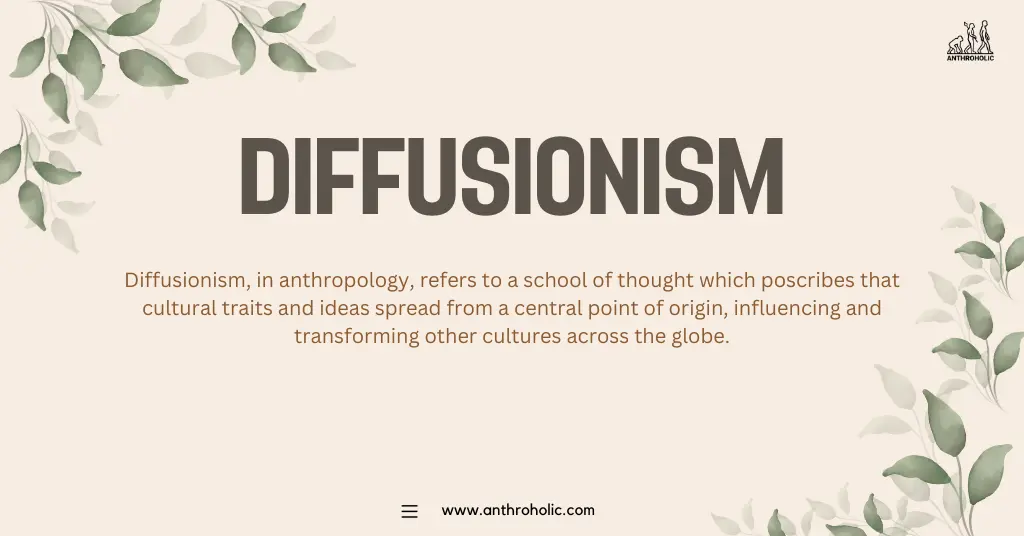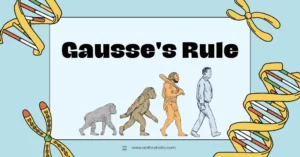AI Answer Evaluation Platform Live Now. Try Free Answer Evaluation Now
Diffusionism
Diffusionism, in anthropology, refers to a school of thought which prescribes that cultural traits and ideas spread from a central point of origin, influencing and transforming other cultures across the globe [1]. This article investigates the fundamentals of diffusionism, its historical development, schools of thought, criticisms and applications in contemporary anthropology.

Origins and Historical Development
Diffusionism emerged as a distinct school of thought in anthropology during the late 19th and early 20th centuries [2]. Primarily, anthropologists were trying to explain the similarities and differences observed among cultures across the globe. They suggested that cultural traits were not developed in isolation but spread from one culture to another. This school of thought greatly challenged the parallel evolution theory, which proposed that similar cultural traits could evolve independently in different societies [3].
Key Figures and their Contributions
| Anthropologist | Contribution |
|---|---|
| Grafton Elliot Smith | Proposed the concept of “Helio-centric Diffusionism”, positing that all complex cultures originated from Ancient Egypt [4] |
| William James Perry | Championed the British School of Diffusionism, emphasising the dissemination of cultural traits from the Ancient Near East [5] |
| Fritz Graebner and Wilhelm Schmidt | Developed the German-Austrian School, focusing on “Kulturkreise” or culture circles, arguing that cultures evolved in a series of stages from simpler to complex forms [6] |
Schools of Thought
Diffusionism is not a monolithic concept but rather consists of different schools of thought that interpret cultural diffusion differently. These include:
- British School (Egypto-centric Diffusionism): Advocates of this school, including G. Elliot Smith and W.J. Perry, argue that all sophisticated civilizations originated from Ancient Egypt and dispersed globally [7].
- German-Austrian School (Culture Circle Theory): This school of thought, promoted by Fritz Graebner and Wilhelm Schmidt, suggests that cultures evolve in distinct stages and that similarities among cultures can be attributed to shared ancestral cultures rather than independent invention [8].
- American Historicist School: This school led by anthropologists like Alfred Kroeber and Clark Wissler, took a moderate approach, accepting both diffusion and independent invention as causes for cultural similarities and differences [9].
Criticisms of Diffusionism
Despite its popularity, diffusionism has been subjected to numerous criticisms, including:
- Oversimplification of cultural exchange: Critics argue that diffusionism oversimplifies the complex processes of cultural exchange and evolution by primarily focusing on the transfer of traits from one society to another [10].
- Ignoring local cultural developments: It has been critiqued for undermining local innovations and adaptations, by overly emphasizing the importance of outside influences [11].
- Eurocentric bias: Early diffusionist theories, particularly the British and German-Austrian schools, have been criticized for their Eurocentric bias, attributing most cultural advancements to Western societies [12].
Applications in Contemporary Anthropology
Although subjected to various criticisms, diffusionism still plays a significant role in contemporary anthropology, offering valuable insights into cultural exchanges and influences. Its key applications include:
- Cultural Studies: It aids in understanding how cultural traits spread and how cultures interact and influence each other [13].
- Archaeology: In archaeology, it helps track the spread of technological and artistic styles, facilitating the understanding of past civilizations [14].
- Linguistics: It provides insights into the spread and evolution of languages and dialects [15].
Influence on Other Fields
Beyond anthropology, the principle of diffusionism has influenced many other academic fields:
- Sociology: Diffusionism aids in explaining how societal norms, beliefs, and behaviours spread across communities and societies [16].
- Psychology: This theory has been used to explore how psychological phenomena, like cognitive biases and heuristics, are adopted and propagated [17].
- Economics and Business: In economics, diffusionism helps explain the propagation of economic practices and business strategies across different regions and industries [18].
| Field | Application of Diffusionism |
|---|---|
| Sociology | Explains the spread of societal norms and behaviours |
| Psychology | Explores the propagation of cognitive phenomena |
| Economics and Business | Describes the dissemination of economic practices and strategies |
Contemporary Critiques and Reinterpretation
Despite its historical significance, diffusionism as a strict doctrine has come under considerable scrutiny in recent decades. Contemporary anthropologists generally prefer a more nuanced approach that recognizes the complex interplay between diffusion, independent innovation, and local adaptations [19]. This integrated approach is often referred to as “historical particularism” or “cultural relativism” [20].
Conclusion: The Ever-Relevant Concept of Diffusionism
Despite its evolution and the debates surrounding its interpretation, the concept of diffusionism remains an integral part of anthropology and related disciplines. It continues to provide a compelling framework for analyzing and understanding how cultural traits disseminate, influencing and being influenced by other cultures. Although the concept of diffusionism may be challenged and refined, its fundamental insights will continue to shape our understanding of cultural evolution and interaction.
References
[1] Winthrop, R. H. (1991). Dictionary of Concepts in Cultural Anthropology. Greenwood Press.
[2] Harris, M. (1968). The Rise of Anthropological Theory: A History of Theories of Culture. Thomas Y. Crowell Company.
[3] Lyman, R. L., & O’Brien, M. J. (2003). Cultural traits: Units of analysis in early twentieth-century anthropology. Journal of Anthropological Archaeology, 22(3), 300-323.
[4] Smith, G. E. (1928). In the Beginning. Watts & Co.
[5] Perry, W. J. (1923). The Children of the Sun: A Study in the Early History of Civilization. Methuen & Co. Ltd.
[6] Graebner, F. (1911). Methode der Ethnologie. Winter.
[7] Smith, G. E. (1928). In the Beginning. Watts & Co.
[8] Schmidt, W. (1931). The Culture Historical Method of Ethnology: The Scientific Approach to the Racial Question. Fortuny’s.
[9] Kroeber, A. L., & Wissler, C. (1927). Source Book in Anthropology. Harcourt, Brace and Company.
[10] Harris, M. (1968). The Rise of Anthropological Theory: A History of Theories of Culture. Thomas Y. Crowell Company.
[11] Boas, F. (1940). Race, Language, and Culture. The University of Chicago Press.
[12] Trigger, B. G. (1984). Alternative archaeologies: nationalist, colonialist, imperialist. Man, 355-370.
[13] Stocking, G. W. (1992). The Ethnographer’s Magic: And Other Essays in the History of Anthropology. University of Wisconsin Press.
[14] Rowlands, M., & Larsen, M. T. (1987). Centre and Periphery in the Ancient World. Cambridge University Press.
[15] Campbell, L. (1997). American Indian Languages: The Historical Linguistics of Native America. Oxford University Press.
[16] Rogers, E. M. (2003). Diffusion of Innovations. Free Press.
[17] Nisbett, R., & Ross, L. (1980). Human Inference: Strategies and Shortcomings of Social Judgment. Prentice-Hall.
[18] Geroski, P. A. (2000). Models of technology diffusion. Research Policy, 29(4-5), 603-625.
[19] Lowie, R. H. (1937). The History of Ethnological Theory. Holt, Rinehart and Winston.
[20] Harris, M. (1968). The Rise of Anthropological Theory: A History of Theories of Culture. Thomas Y. Crowell Company.




